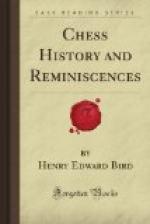------
The Chinese claims made apparently rather for than by them, are recorded in the annals of the Asiatic Society as being in respect of a game called “War Kie,” played with 360 pieces, said to have been invented by Emperor Yao so far back as B.C. 2300, the next account is of a game called Hsiang Kie, attributed to Wa Wung B.C. 1122, with 16 pieces on each side, like draughts with characters written on each so recently as 1866, it was claimed to be played all over the country. The great dictionary of Arts and Sciences dedicated to our King in 1727, merely says:
“The Chinese claim to date back their acquaintance with chess to a very remote period.” The Chinese call chess the game of the Elephant, and say that they had it from the Indians. The Haipiene or great Chinese Directory under the word Sianghki, says that this happened in the reign of Vouti, about the year of Christ 537. Notwithstanding this statement there is an account of Real Chess given in 1793, by Eyles Irwin, Esq., a gentleman who had passed many years of his life in India, and contained in a communication to the President of the Irish Society. He says 379 years after the time of Confucius (which is equal to 172 B.C.), King Cochu, King of Kiangnan, sent an expedition into the Shensi Country, under the command of a Mandarin, called Hansing, to conquer it, and during the winter season, to allay the discontent of his army at inaction, chess was invented to amuse them, with results entirely satisfactory.
The board, or game, Irwin says, is called Chong Ki or Royal Game. Forbes says the game is called by the Chinese “Choke Choo Hong Ki.”
The board is 64 squares with a chasm in the middle, the army 9 pieces, 2 rocket boys, and 5 pawns on each side.
It has become the fashion to this day to dish up the great poets’ lines more or less seasoned or to repeat, one or the other of the fabulous stories, or fallacious theories so constantly put forward in regard to the origin of chess, so it may be not amiss to state what is known or can be gathered in regard to it, concerning the claims of countries other than India.
Such consideration as can be found devoted to the game in Egypt mostly relates to hypothesis and conjectures in regard to the inscriptions on tombs and on the walls of temples and palaces; some discussion has arisen in our own time, in notes and queries, and particularly in regard to Mr. Disraeli’s references in the book Alroy, concerning which the Westminster Chess papers in 1872, instituted a criticism. Chapter 16 of Alroy begins “Two stout soldiers were playing chess in a coffee house,” and Mr. Disraeli inserts on this the following note (80). “On the walls of the palace of Amenoph ii, called Medeenet Abuh, at Egyptian Thebes, the King is represented playing chess with the Queen. This monarch reigned long before the Trojan War.”




